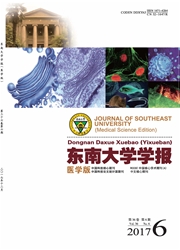

 中文摘要:
中文摘要:
目的:研究高脂饲料饲养ApoE-/-小鼠建立动脉粥样硬化动物模型的过程中CD11b+Gr-1+髓系抑制性细胞的变化趋势,以期揭示高脂血症导致动脉粥样硬化的另一种可能的细胞机制。方法:将12只雄性ApoE-/-小鼠随机分为对照组(n=6)和模型组(n=6),分别给予普通饲料与高脂饲料处理。8周后酶法和免疫比浊法检测血清甘油三酯(TG)、总胆固醇(TC)、低密度脂蛋白胆固醇(LDL-C)、高密度脂蛋白胆固醇(HDL-C)、载脂蛋白A-I(apoA-I)和载脂蛋白B(apoB)水平;HE染色观察主动脉病理形态学改变;油红O染色观察内皮下间隙脂质沉积情况;流式细胞术分析骨髓、脾脏、外周血中CD11b+Gr-1+髓系抑制性细胞的百分比,比较其与对照组之间的差异度。结果:8周的高脂饲喂使得ApoE-/-小鼠血脂水平显著改变,动脉粥样硬化斑块明显形成,CD11b+Gr-1+髓系抑制性细胞占骨髓单个核细胞比例显著升高,并进一步被动员释放到外周组织,导致循环中CD11b+Gr-1+髓系抑制性细胞显著增加。结论:高脂饲料饲养ApoE-/-小鼠能使CD11b+Gr-1+髓系抑制性细胞的生成显著增加,并向循环和外周组织释放。高脂血症可能是通过激活CD11b+Gr-1+髓系抑制性细胞的途径来参与动脉粥样硬化的发生、发展。
 英文摘要:
英文摘要:
Objective: To study the variation trend of CD11b+Gr-1+myeloid derived suppressor cells(MDSCs) in ApoE-/-mice during the formation of their atherosclerosis by high-fat diet,and furthermore to explore the cellular mechanism of hyperlipidemia-induced atherosclerosis.Methods:Total 12 male ApoE-/-mice were randomly divided into control group(n=6)and model group(n=6),respectively fed with normal diet and high-fat diet.After 8 weeks,serum lipid levels(total triglyeride,total cholesterol,HDL cholesterol,LDL cholesterol,apoA-I and apoB) were measured by enzymatic method and by immunoturbidimetery.Lesions of aortic arteries were stained with hematoxylin eosin.Lipid-accumulation in subendothelial space was observed by oil red O staining.The percent of bone marrow,spleen,and peripheral blood CD11b+Gr-1+MDSCs was measured by flow cytometry analysis,and compared with the control group.Results:High-fat diet for 8 weeks made a significant change of serum lipid and made ApoE-/-mice form obviously atherosclerotic plaque.The percent of CD11b +Gr-1+MDSCs in total mononuclear cells of bone marrow was significantly increased,and furthermore,these cells were mobilized and released into the peripheral tissue;consequently,the amount of CD11b+Gr-1+MDSCs in spleen and circulating pool increased significantly.Conclusion:Bone marrow CD11b+Gr-1+MDSCs of ApoE-/-mice fed with high-fat diet can be mobilized and be released to the circulation and peripheral tissue.It indicates that hyperlipidemia may participate in the formation and development of atherosclerosis by activating CD11b+Gr-1+MDSCs pathway.
 同期刊论文项目
同期刊论文项目
 同项目期刊论文
同项目期刊论文
 期刊信息
期刊信息
